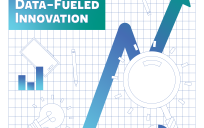 Governments are at an exciting point in their data journey. For the past several years, we have found ourselves focusing on making our communities smarter through the use of data to drive decisions. But the reality is that data doesn’t drive anything. As Richard Saul Wurman, the creator of the TED Conference once said, “Nobody cares about big data, they care about big analytics,” and he’s right. Data by itself doesn’t solve problems or bring value to an organization. We need to move beyond the data, and work on harnessing its value to the organization.
Governments are at an exciting point in their data journey. For the past several years, we have found ourselves focusing on making our communities smarter through the use of data to drive decisions. But the reality is that data doesn’t drive anything. As Richard Saul Wurman, the creator of the TED Conference once said, “Nobody cares about big data, they care about big analytics,” and he’s right. Data by itself doesn’t solve problems or bring value to an organization. We need to move beyond the data, and work on harnessing its value to the organization.
If you think about an organization as a vehicle, what drives it forward? In this context we’re assuming driving an organization forward includes some sort of digital transformation which leads to better decision making, etc. Data doesn’t make the wheels turn. Data is the fuel. Fuel won’t get you anywhere without a way to convert it into energy, which is the role of the engine. In this context, the engine is analytics. Data fuels analytics, and analytics is what moves the organization forward because it provides someone the ability to take action, and action leads to value.
Governments are innovating with their uses of data analytics to improve all aspects of their communities. For instance, Cobb County, Georgia performed density-based clustering and used machine learning through their Esri GIS platform to perform a crash accident analysis on 10 years of data – more than 700K incidents – of fixed-object crashes (where a vehicle runs off the road and hits trees or guardrails). The analysis showed that these accidents were found to occur where slopes were steep and curves sharp, allowing the county to allocate limited resources appropriately to reduce the steepness of certain slopes or the sharpness of certain curves. Ten years of data – that’s a lot of data! – but the real value was achieved when analytics on that decade of data enabled impactful decision making.
It’s important to note that the “path to value” starts with data, then moves to reporting, then analysis, then decision, then action, and finally value. Sometimes, when it comes to data analytics, we might not reach the end of the path of value, and that is acceptable. We can often learn more from our failures than we do from our successes. At least if we’re performing analysis, we are using our data, and trying to make better decisions. For governments to be innovative, they need to have a culture that accepts failure, because failure is part of innovating.
Ideally, the more people in an organization using analytics, the better. The vision here is turning any employee, elected official, or citizen into analysts. Technologies like artificial intelligence, machine learning, and edge analytics provide this functionality and web-based software allows easy-to-use, drag-and-drop data exploration, visualization and analytics, bringing analytical capabilities into the hands of front-line workers, elected officials and citizens.
How can you begin to move your government agency or department or organization toward an analytics-driven approach? Your culture should support:
- Acceptance of failure as a part of innovation
- Fueling analytics with data to realize value based on action from better decisions
- Striving to extract the most value from data
- Enabling anyone to perform analysis
You can help drive your organization by:
- Promoting data-sharing practices
- Communicating the value of analytics
- Helping others leverage their data to drive analytics, leading to better decisions, action and ultimately, making a difference through value.
This is an exciting time for governments at all levels to move to the next stage of their data journey. The insights garnered from data analytics are impacting decisions across the board in innovative ways. The data is there – like in the case of Cobb County, Georgia, often in droves – the challenge is to put that data to work for your organization in meaningful ways.
Adam Carnow is part of the GovLoop Featured Contributor program, where we feature articles by government voices from all across the country (and world!). To see more Featured Contributor posts, click here. You can follow Adam on Twitter or LinkedIn.





Great article! I like the insight on enabling anyone to do their own data analysis. We’re starting to do that with drag and drop tools like Tableau but it still seems like an uphill battle to really capitalize on all the data we have available.